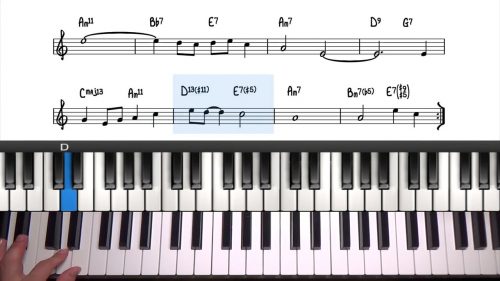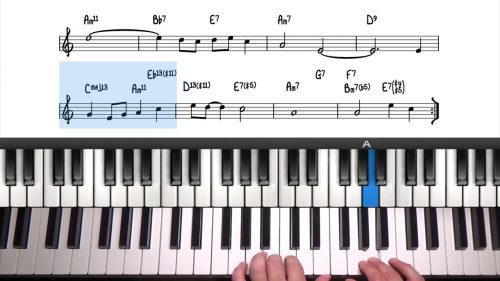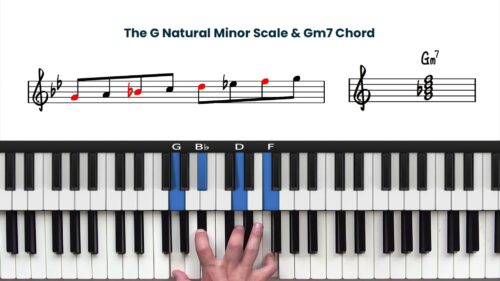Summertime Piano Accompaniment
Welcome to this accompaniment tutorial on the famous tune "Summertime".
"Summertime" is a favorite song amongst both singers and players. The form is nice and simple, and the lyrics are fantastic… particularly the 2nd verse. But the best thing about this tune is that audiences love it, it’s well-known and always a brilliant number to add to your set!
Accompanying Step-By-Step
In this lesson, you can follow along as we build up an arrangement step-by-step from plain and simple, to complex and advanced.
If you have watched the PianoGroove solo piano tutorials on Summertime, you will remember that the tune is covered in the key of A Minor. For the purpose of this lesson, we will cover the tune in D Minor. I prefer to sing it in Dmin since it puts the melody range squarely in the sweet spot of my voice.
Start With Simple Triads
The first step is to strip down the harmony to triads. We simplify the chord changes to their absolute bare bones to help you understand and memorise the underbelly of the tune. There’s plenty of space for the singer’s melody and as well as hearing your own ideas.
Since the mechanics of playing it are easier, you will now have more capacity to work thru the baselines, voicings, a variety of tempos, and styles. In addition, you can even really listen to the message of the lyrics.
Basslines & 7th Chords
Start by playing just roots and 5ths in your left hand, then simple triads in roots and inversions. This great for a first run thru with a singer at a rehearsal or jazz jam, and when you are just getting know the tune. This could also be heard as a poppier version of this song.
When we do introduce basslines, we keep them simple. This is a nice to time to introduce 7th chords in your right hand, rather than just simple triads. However, notice that we are not yet included any of the upper extensions or alterations.
Practice Tips
-
If you are not a singer, then partnering up with a singer is something you'll want to pursue.
-
It can be mutually beneficial for you both to experiment and collaborate on the music in a safe rehearsal environment.
-
Experimenting is important to hearing and deciding what sounds best to you.
- You'll know when you're hitting the mark because you'll love it, and you'll love to play it.







I’m enjoying your videos, well done. my question here is — does the melody note need to be in the chord some where? I understand the piano should not play the melody of the song, but should the note generally be in the chord that’s being played? e.g., at bar 14, you mention that the #5 is needed since the melody note is F, but at bar 7 (chord Bm7b5), the melody note is E which is not in that chord. thanks!
Hi Joel,
Good questions!
Generally, you should not play the melody note in your voicings because the singer has the melody note covered. However, there are some exceptions, such as if the singer is unsure or struggling to find the right notes, then you can help out by including the melody at the top of your voicing to guide the singer.
In bar 14, the #5(F) is in the melody, and so if you play the natural 5 in your voicing, it will clash with the singer who is singing the #5 (just a half step apart which is a very dissonant interval) This would make the singer sound off, when in reality it’s just that the voicing clashes with the melody note that the vocalist is singing.
The key point is that: you must be aware if there is an alteration in the melody, and make sure that you are not adding any dissonant/clashing harmony in your accompaniment. The same would apply if the natural 5 was in the melody, and you played a #5 in your voicing, it would clash with the singers melody line.
Regarding the E over B-7b5 in bar 7… It doesn’t matter if the melody note is part of the chord or not. What matters is making sure that the voicings in your accompaniment do not clash with the melody note. Generally, this can be achieved by sticking to the pillars of the chord (R-3-5) and avoiding the upper extensions (9,11,13) and alterations (b9, #9, #11)… those notes will be more likely to create dissonant harmony so play it safe, and stick to the pillars of the chord. Then the melody will be free to move all around while you hold down the basic harmony structure in a non-obtrusive way. Is it more clear now? Please don’t hesitate to ask more questions if not. Thanks! – Lyndol
yes, that makes sense. thanks